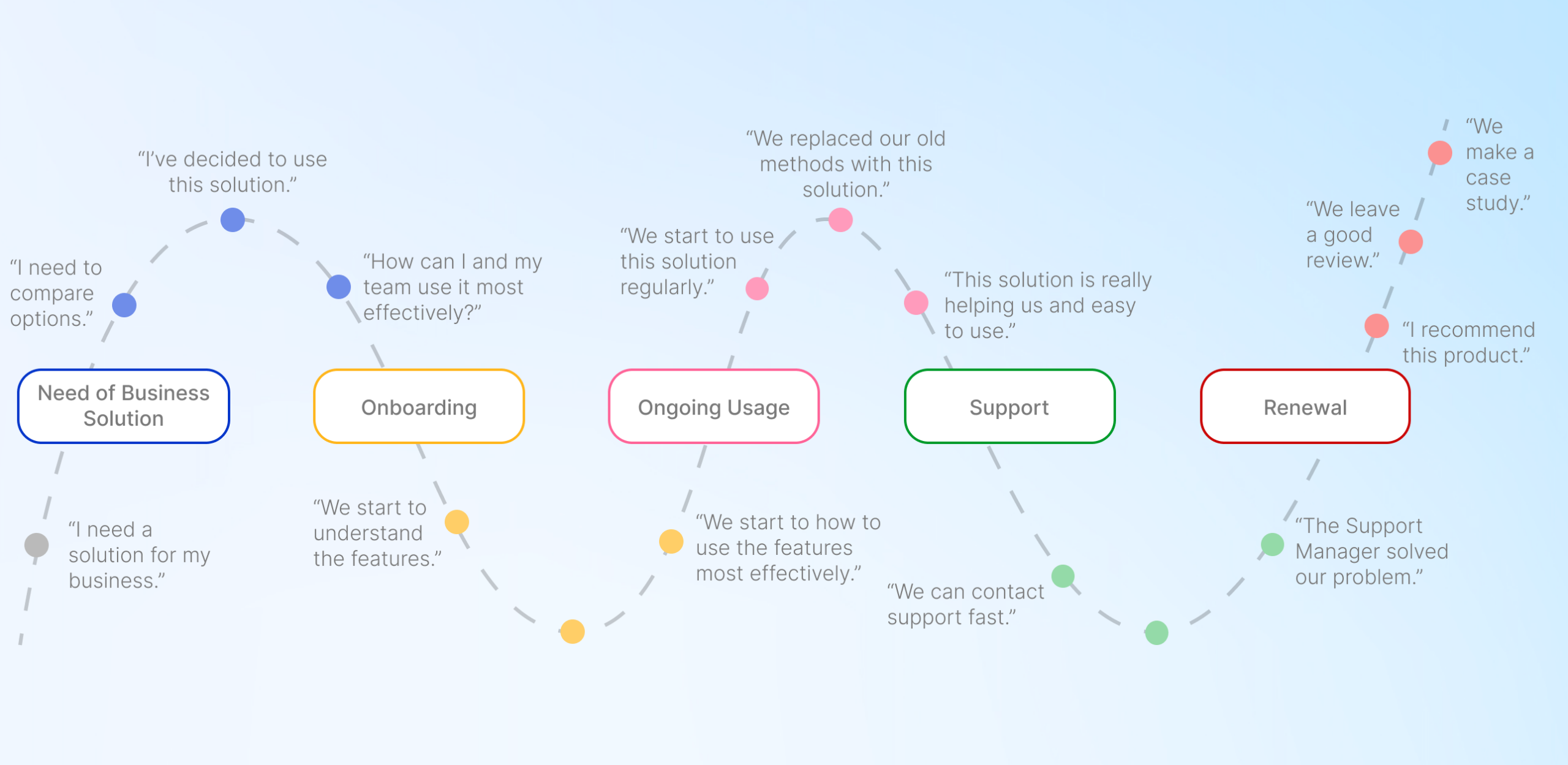What is even customer journey mapping, right? It is the process of visualizing the road your users use while becoming promoting advocates for your product. And I am going to teach you what you need to know about it.
Think of this article as your map for creating a map – a bit meta, I know, but stick with me. In this article, you are going to explore 11 proven steps, packed with insights and practical tips.
By the end of this, you’ll have a clear understanding of how to chart your customer’s journey, making your B2B customer interactions smoother and more effective.
TL;DR
- Recognize the impact of a well-defined customer journey map on customer decision-making and retention
- Align your journey map with specific business objectives, whether focusing on quick sales or long-term relationships.
- Develop detailed personas to better understand and meet customer needs.
- Determine crucial moments in the customer journey that impact customer experience and decisions.
- Use analytics tools and CRM for informed decision-making.
- Regularly evaluate key metrics to assess the effectiveness of your journey map.
- Ensure all departments align with the journey map insights.
- Keep your map up-to-date with changing customer needs and market trends.
Before we dive in deep, let’s start with the basics of b2b customer journey. Let’s refresh our memory and ensure we’re all on the same page.
What is a customer journey?
In simple terms, a B2B customer journey is the process that a business goes through when interacting with your product or service. It’s the path they take from the moment they first become aware of your business, through the purchasing process, and beyond into customer retention and loyalty.
This journey is not linear, but rather a complex web of interactions and touchpoints that can vary greatly depending on the specific business and its needs. B2B customer journeys are often more complex than B2C journeys due to the larger number of stakeholders involved, longer sales cycles, and higher stakes in decision-making.
Understanding this journey is the key to creating a successful B2B customer journey map. It allows you to visualize the path your customers take, identify potential pain points, and find opportunities to enhance the customer experience.
Now that we have a clear understanding of what a B2B customer journey is, let’s move on to discussing what is a customer journey map.
What is a customer journey map?
A B2B customer journey map is a strategic tool that provides a visual representation of the customer’s experience with your product or service. It outlines the steps that a business customer takes from the initial discovery of your product or service, through the decision-making and purchasing processes, and into the post-purchase phase where customer retention and loyalty are established.
A B2B customer journey map is the predicted steps your customers might take after they decide to sign up for your tool. Knowing what steps they will take helps you guide them better, and determine the best times to promote upgrades, or surprise them to make them love you even more.
This map serves as a guide to understanding your customers’ needs, motivations, and pain points at each stage of their journey. It enables you to identify opportunities for improvement and innovation, and to align your marketing, sales, and customer service strategies to deliver a seamless and satisfying customer experience.
In essence, a B2B customer journey map is like a roadmap that helps you navigate the complex terrain of B2B customer relationships, making it an invaluable asset in your customer-centric business strategy.
5 Stages of B2B Customer Journey
In the world of B2B SaaS, knowing the steps customers go through is really important for success. These steps show how customers move from realizing they need your product, to starting to use it, to using it regularly and finally deciding to keep using it.
Each step is a chance to make the customer’s experience better, which can both improve customer retention and make them more loyal and likely to stay with you.
Next, we’ll look at each of these stages of customer journey closely to help you really understand the B2B customer journey.

“Need for Business Solution” starts when a company discovers a gap or difficulty in its operations that demands a new business solution.
After choosing a solution, “Onboarding” begins. B2B onboarding includes educating the whole account, which might include several users from various departments.
“Ongoing Use” means the company uses the product regularly after onboarding. This stage is for using the service for maximum efficiency and productivity.
“Support” is necessary because problems in B2B can have serious consequences.
“The last step is “Renewal“, deciding whether to keep using the tool. B2B companies don’t just buy something once; they think about how much the tool has helped them.
In other terms, it’s about painting a clear picture of their experiences, expectations, and interactions with your brand, helping you to strategize and align your services for maximum impact and efficiency.
What would happen without it? Well, you might still succeed, but the chances would be lower.
Crafting a Customer Journey Map in 11 Steps
Creating a customer journey map is crucial to understanding your customers’ experience with your product or service. It’s a strategic tool that visualizes the process a customer goes through from the moment they discover your product to the point of purchase and beyond.
This guide will walk you through the 11 steps to create an effective B2B customer journey map. These steps are categorized into four main sections
- Identifying and Understanding Your Audience
- Defining Key Stages and Touchpoints
- Data Gathering and Research Techniques
- Analysis and Application of Your Customer Journey Map.
By the end of this guide, you’ll have a comprehensive understanding of how to create a customer journey map that will help you improve your customer experience and ultimately grow your business.
1. Understanding the Importance of Customer Journey Mapping in B2B Contexts
Let’s make a quick list to visualize the effects of having a clear customer journey map:
- Your B2B customers are comparing lots of competitors. If you aren’t clear with the path you provide them, they will not even start considering your solution as an option.
- 55% of customers don’t bother to understand a product that they couldn’t understand at first glance. Your signup page, onboarding, help modules, surveys, and referral programs are all a part of the journey, and these are most of the elements that the user needs to understand your product.
- By mapping out this journey, you gain valuable insights into the pain points, motivations, and decision-making processes of your customers. This understanding is essential for coming up with tailored strategies and solutions that resonate deeply with your customers.
- The customer journey map will also help you come up with more solid strategies. The journey map will divide the user journey into steps. Assigning different metrics for each step will allow you to have a better look at how your customers are doing.
2. Goals Setting: Tailoring Your Approach to Your Business Model
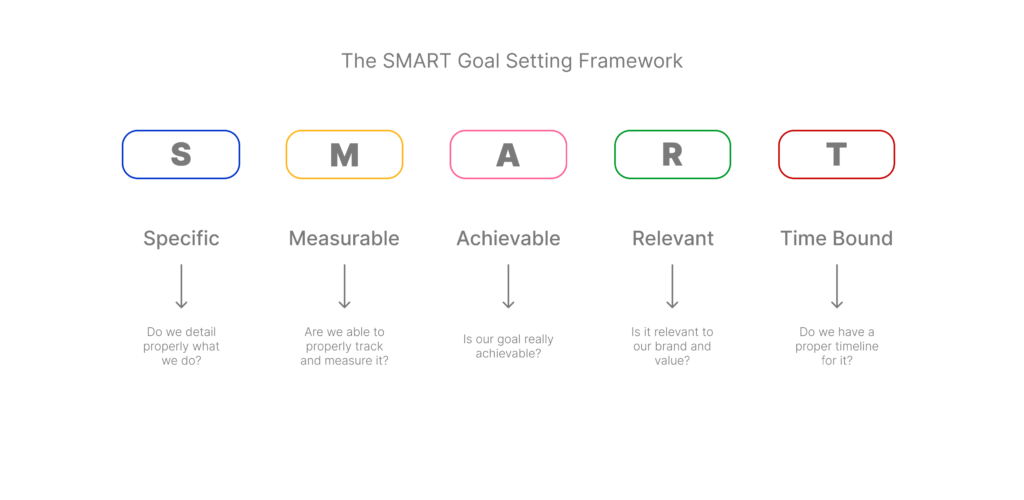
Setting goals for your journey map means you are customizing your strategy to align seamlessly with your specific business model.
Are you aiming for long-term customer relationships, or is your focus on quick, efficient sales cycles? Understanding and setting these goals will help you in creating a journey map that’s not just a “map”, but a strategic tool.
➡️ If you are looking for quick sales, then keep the pre-onboarding process shorter and promote referrals at an earlier stage.
➡️ If you are looking for long-term customer relationships, then tailor the sales and onboarding processes, and keep them a bit longer (if necessary).
Identifying and Understanding Your Audience
Well, a “customer journey map” couldn’t exist without a “customer”. That’s why you have to know who “your customer” is and what they want.
Here are the easiest steps to achieve that goal:
3. Segmenting Your Customer Base: The Foundation of an Effective Journey Map
Not all your customers are the same. Especially in a B2B context where the number of customers is lower, but the value is much higher. After all, you aren’t selling 50$ sneakers, but an experience, and value for their business instead.
Back to our topic, segmenting your users based on certain criteria and creating a custom journey map according to each type’s needs is crucial. It involves categorizing your customers based on specific criteria like industry, company size, or buying behavior.
Effective segmentation leads to a more focused and impactful customer journey map, paving the way for personalized marketing strategies and improved customer experiences.
4. Creating Detailed Customer Personas
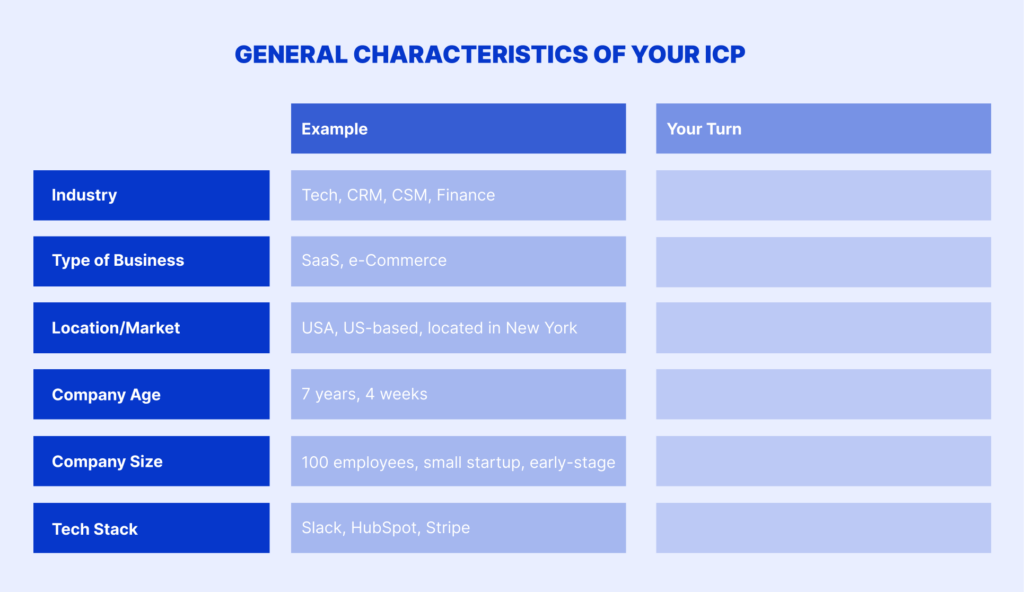
Some people love the idea of customer personas, and others hate it much more than they hate their enemies. My take on the subject is that as long as the customer persona represents a real user type and not a hypothetical being.
Your journey will bend and shape according to your customer profiles and personas anyway. Whether you see it or not.
Therefore, if you create the ideal personas first and map out the ideal customer journey, accordingly, you will have the advantage of getting them to love your product at the first interaction anyway.
Ask yourself:
- What is the problem they are facing and why did they choose you to solve it?
- What alternatives were considered, or were alternatives considered?
- What do your customers love about your tool?
- What are the users’s aspirations?
Defining Key Stages and Touchpoints
Finally, we are at the customer journey itself. This is where you start to meet customer expectations and define the steps of the customer journey – which will affect your whole onboarding and retention strategies.
5. Mapping the Customer Journey Stages in B2B
There is a huge load of different stages that you “need to follow” while creating your customer journey map. Well, in reality, you have done most of the work I will list out below, so, feel free to pick and choose which ones you haven’t done yet and need to do:
- Touchpoint analysis: Find all the touchpoints where your customers interact with your product. More information on this topic is below.
- Collect data: Once you have your touchpoints, collect data about them. Which ones are more frequently used, what is the difference between different personas, and so on?
- Visualize the map: Create the first draft of your map. While doing so, get help from the research you have done in the previous steps.
- Highlight pain points: Figure out what the most challenging steps or transitions between steps are. You will have to find ways to smooth these steps out.
- Implement and Monitor: Put your proposed improvements into action and continually monitor the results, adjusting your strategy as necessary.
- Add value: Once you start to generate some data from this journey map, figure out what and where you can make improvements.
- Get feedback: A simple “How was your onboarding?” or “How can I help you better?” will make a customer think deeply about your product and evaluate it further. So while you are getting your feedback, they are putting more thought into you! (Aww…)
6. Identifying Crucial Customer Journey Touchpoints
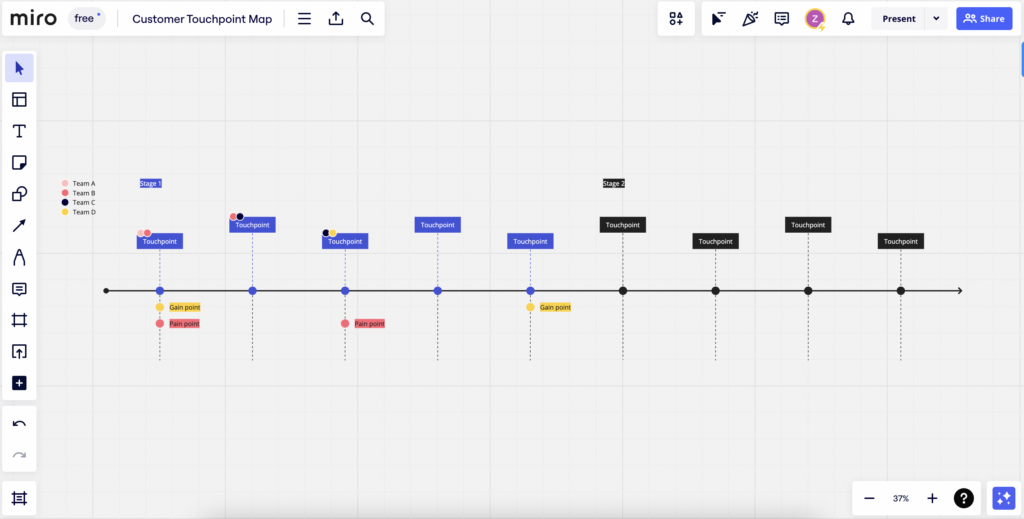
Identifying crucial customer touchpoints is all about recognizing the key moments that significantly affect the customer’s experience and decision-making process. PS. You can use Miro to create visually appealing maps.
In the B2B landscape, these touchpoints could range from:
- the first website visit,
- interaction with marketing content,
- sales calls,
- product demos,
- after-sales support,
- and feedback mechanisms.
Understanding these touchpoints allows you to optimize each interaction, ensuring they are as effective and engaging as possible.
Data Gathering and Research Techniques
7. Research Approaches Unique to B2B Markets
The research methods and priorities for B2B and B2C aren’t the same. A B2B business needs to dive deeper into each customer and know how to customize. It focuses on understanding complex business needs, industry-specific challenges, and decision-making hierarchies within organizations.
Don’t swim on the surface, dive deep.
💡 Have interviews with key figures in your industry. Bonus points if you use this interview as a base for your customer profiling.
💡 Ask others. I bet you are in a few Slack or Facebook groups, or a LinkedIn community about your job. Ask those people. If you are just starting and aren’t on any groups, just ask Quora or Reddit!
💡 And lastly, look out for patterns. Since your customer base will have the same problem, there will be certain groups that want to solve it your way. Analyze their patterns and use this data in your segmentation.
8. Using Resources for Informed Insights
It is already post-pandemic and I just know for a fact that you are using other 3rd party tools to figure out your product. That’s only natural.
And I also bet that you have at least one analytics tool and one CRM integrated.
That is amazing news because the information that those tools provide will be your best friend at all obstacles. The key is to integrate and analyze this information to gain a comprehensive understanding of the market landscape, customer behavior, and emerging trends.
Listen to your 3rd party tools and try to detect changes in behavior depending on the customer journey. If the numbers are mostly consistent, you are on the right path.
But if the numbers are too inconsistent to understand anything, you might want to go back to step 5.
Analysis and Application of Your Customer Journey Map
9. Measuring and Analyzing the Success of the Customer Journey
Measuring and analyzing the success of your B2B customer journey map is like conducting a health checkup for your business strategy. It includes using customer feedback data and evaluating key metrics – such as customer satisfaction, conversion rates, and retention rates – to understand how effective the journey map is for the customers.
Tools like UserMotion are invaluable here because they allow you to see what customers are actually doing and feeling during their onboarding process at the account level.
This kind of tracking helps you understand the story behind the numbers, revealing customer behaviors and activities that are essential for shaping a successful journey and leading to long-term paying customers.
10. Synchronizing Insights Across Teams
This step is about ensuring that marketing teams, sales, customer service, and product development teams are all aligned and informed about the insights gathered from the journey map.
Creating this map isn’t the job of one specific person, it is a collective process. Without understanding the different views of users from different departments, your journey map will be incomplete.
So, whether you do a big call or a shared document, make sure that all teams are content with the map, especially the steps that regard their input.
11. Regularly Updating Your Journey Map
Everything will change. Your business, your customers, their needs, and even the whole market.
That’s why you need to regularly update your journey map to keep up with the trends.
You may need to change your linear map into one that has more flows, or your simple journey map into one that is more in-depth.
Creating a working customer journey map is not too difficult since all you need is the customer data, that you should already have for your positioning, GTM, marketing, and overall customer journey success efforts.
All you need to do is look at the data from a different perspective and bring the users into the process.
Once you invest enough time into having a solid journey map, all those will become easier:
- Onboarding,
- Surveying,
- Sales,
- Referrals,
- And segmentation.
[EXTRA] Customer Journey Map Templates
Creating a customer journey map from scratch can seem daunting. Luckily, there are numerous online tools that offer templates and examples to simplify this task.
These platforms offer user-friendly interfaces and a diverse range of templates, allowing you to construct an effective B2B customer journey map.
Additionally, these tools allow you to export your completed map in various formats, such as Excel, Word, PDF, and more, facilitating easy sharing and collaboration.
Miro
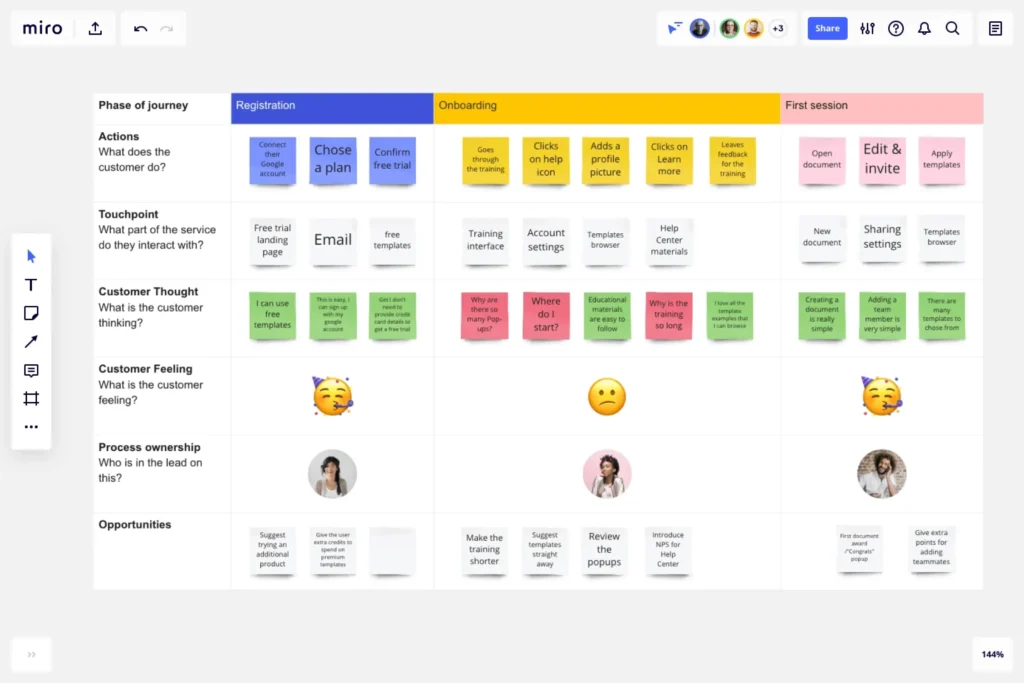
Miro is a collaborative online platform that provides a variety of templates for creating customer journey maps. It’s a great tool for visualizing and understanding your customer’s experience.
👉 https://miro.com/templates/customer-journey-map
Canva
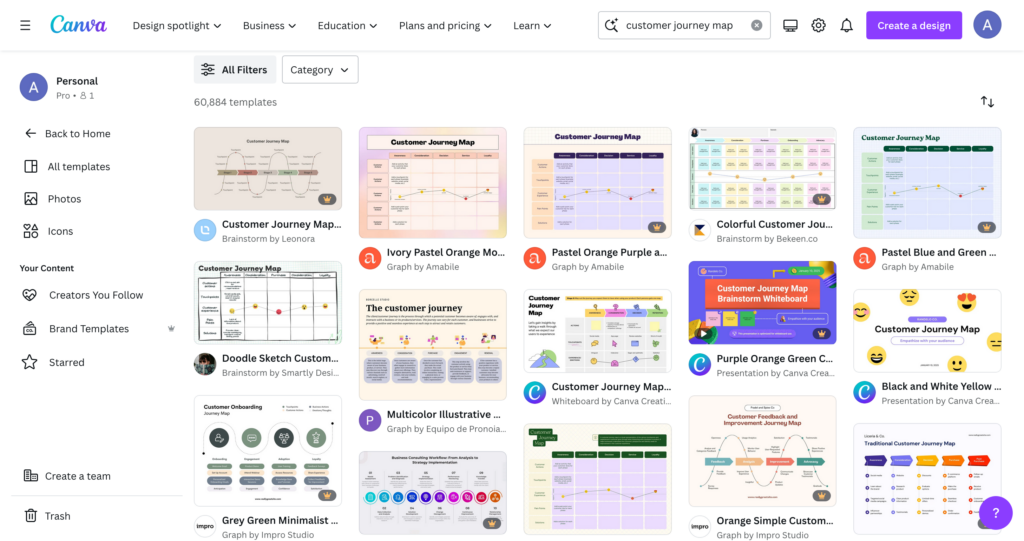
Canva offers a wide range of free templates for customer journey map designs that you can easily customize and share. There are countless options to choose from, including designs made by our creative community. These templates are designed to make your task easier and more efficient.
👉 https://www.canva.com/templates/s/customer-journey-map/
Mural
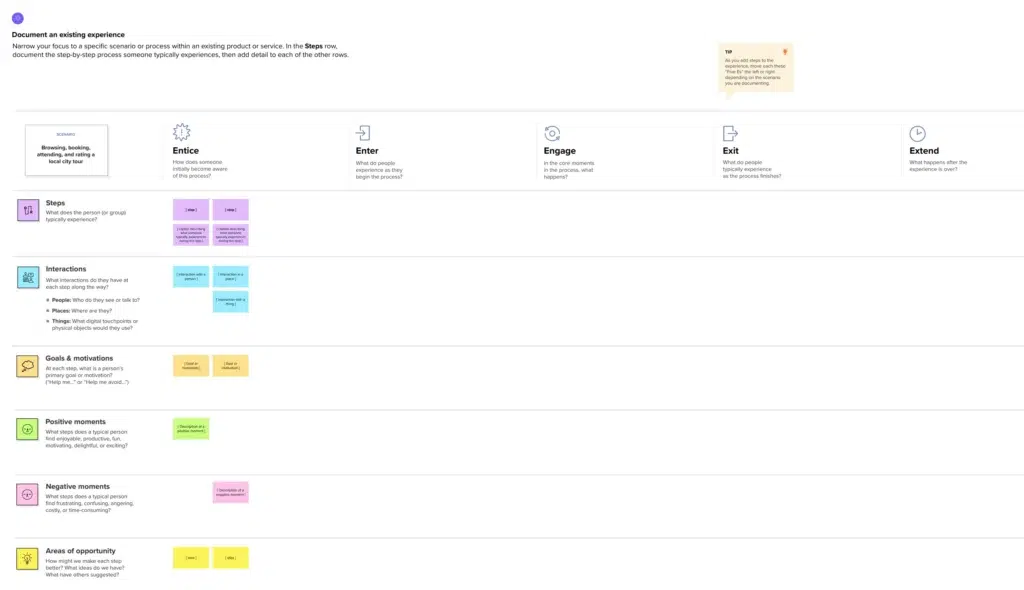
Mural is an excellent tool for creating interactive, collaborative customer journey maps. It’s a digital workspace that allows teams to visualize the customer’s experience, making it easier to identify opportunities for improvement.
👉 https://www.mural.co/templates/customer-journey-map
Final Thoughts
Creating a B2B customer journey map is an essential step in understanding your customers’ experience with your product or service. It allows you to visualize the path your customers take, identify potential pain points, and find opportunities to enhance the customer experience.
Remember, the journey map is not just a static document, but a living tool that should evolve as your business and customers change. Regularly updating your journey map will ensure it remains relevant and effective.
By following the steps outlined in this guide, you’ll be well on your way to crafting a comprehensive and insightful B2B customer journey map. This will not only improve your customer experience but also increase customer retention and contribute to the overall growth and success of your business.

